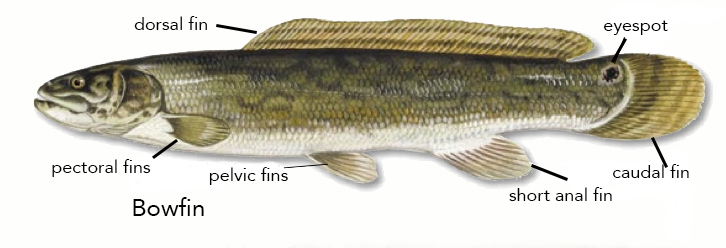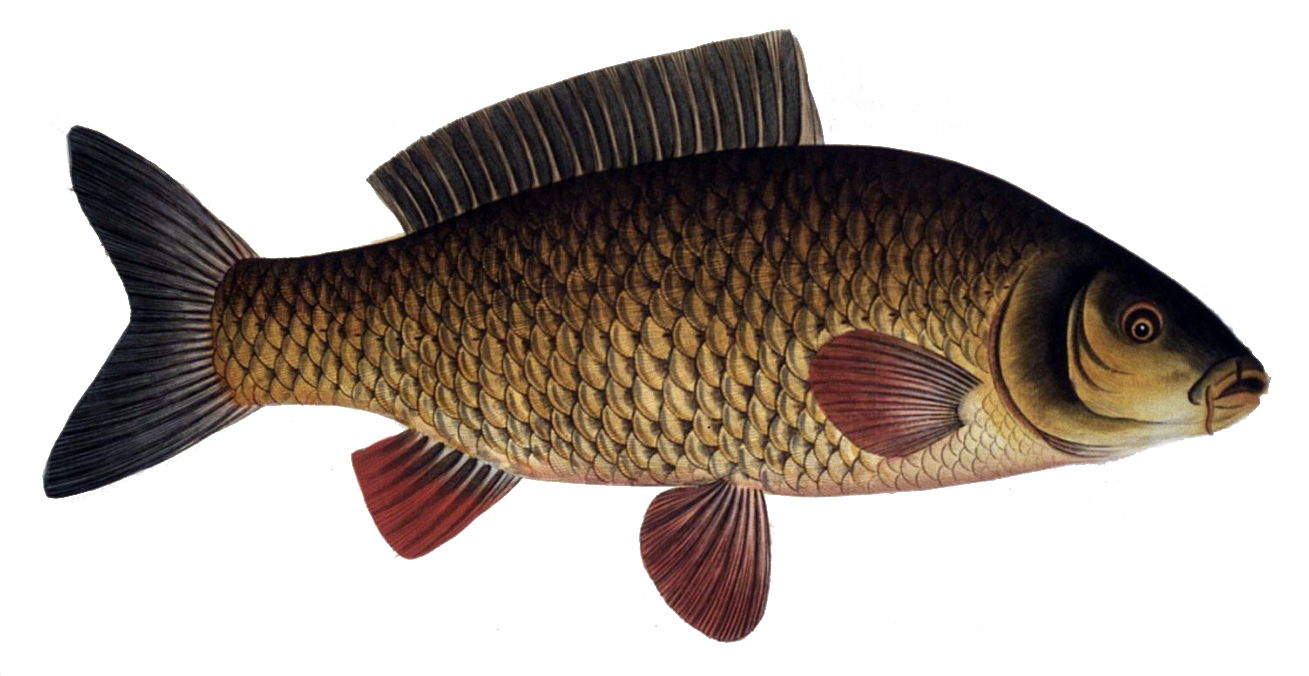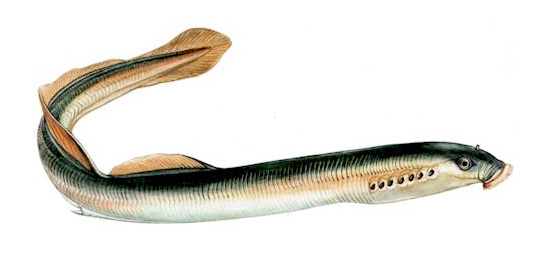|
Halecomorph
Halecomorphi is a taxon of ray-finned bony fish in the clade Neopterygii. The sole living Halecomorph is the bowfin (''Amia calva''), but the group contains many extinct species in several families (including Amiidae, Caturidae, Liodesmidae, Sinamiidae) in the order Amiiformes, as well as the extinct orders Ionoscopiformes, Panxianichthyiformes, and Parasemionotiformes. The fossil record of halecomorphs goes back at least to the Early Triassic epoch. The Halecomorphi exhibit a combination of ancestral features, such as most heavily mineralized scales, but also by more derived or "modern" features, particularly in the structure of the skull (e.g. position and shape of preopercles). Unique derived traits (synapomorphies) of the Halecomorphi include: *Unique jaw articulation in which the quadrate and symplectic participate in the joint. *Lengthened dorsal fins (in some species) *Two biconcave vertebrae per segment in the posterior body region (a condition known as diplosp ... [...More Info...] [...Related Items...] OR: [Wikipedia] [Google] [Baidu] |
Amia Calva
The bowfin (''Amia calva'') is a bony fish, native to North America. Common names include mudfish, mud pike, dogfish, grindle, grinnel, swamp trout, and choupique. It is regarded as a relict, being the sole surviving species of the Halecomorphi, a group of fish that first appeared during the Early Triassic, around 250 million years ago. The bowfin is often considered a "primitive fish" because they have retained some morphological characteristics of their early ancestors. The closest living relatives of bowfins are gars, with the two groups being united in the clade Holostei. Bowfins are demersal freshwater piscivores, commonly found throughout much of the eastern United States, and in southern Ontario and Quebec. Fossil deposits indicate Amiiformes were once widespread in both freshwater and marine environments across North and South America, Europe, Asia, and Africa. Now, their range is limited to much of the eastern United States and adjacent southern Canada, including th ... [...More Info...] [...Related Items...] OR: [Wikipedia] [Google] [Baidu] |
Cipactlichthys Scutatus
''Cipactlichthys'' is a genus of extinct holostean fish from the Lower Cretaceous of Mexico. The only known species is ''Cipactlichthys scutatus''. Discovery and etymology ''Cipactlichthys scutatus'' is known from two fossils discovered in the Tlayua Formation near the town of Tepexi de Rodríguez, in Puebla, Mexico. The Tlayua Formation, is Albian (Early Cretaceous) in age, interpreted as an epicontinental marine deposit. Due to its high quality preservation and abundance of fish fossils, the formation is considered one of the most important sources of Cretaceous fishes in Mexico. The genus name is a combination of ''Cipactli'', the Aztec mythological sea monster said to be part fish and part reptile, and ''ichthys'', Greek for "fish". The specific epithet ''scutatus'' is Latin for shield, referring to the large dorsal and ventral scutes. Description ''Cipactlichthys'' is an elongate fish, approximately 130 mm in total length, or 100 mm in standard length. Its ... [...More Info...] [...Related Items...] OR: [Wikipedia] [Google] [Baidu] |
Sinamiidae
Sinamiidae is an extinct family of ray-finned fish. They are halecomorph fishes endemic to Early Cretaceous freshwater environments in eastern Asia. Along with Amiidae, it is one of two families that makes up the superfamily Amioidea The Amiiformes order of fish has only one extant species, the bowfin (''Amia calva''). These Amiiformes are found in the freshwater systems of North America, in the United States and parts of southern Canada. They live in freshwater streams .... The two are distinguished by the shape of their scales. References Amiiformes Prehistoric ray-finned fish families Cretaceous bony fish Early Cretaceous fish of Asia {{Amiiformes-stub ... [...More Info...] [...Related Items...] OR: [Wikipedia] [Google] [Baidu] |
Bowfin
The bowfin (''Amia calva'') is a bony fish, native to North America. Common names include mudfish, mud pike, dogfish, grindle, grinnel, swamp trout, and choupique. It is regarded as a relict, being the sole surviving species of the Halecomorphi, a group of fish that first appeared during the Early Triassic, around 250 million years ago. The bowfin is often considered a "primitive fish" because they have retained some morphological characteristics of their early ancestors. The closest living relatives of bowfins are gars, with the two groups being united in the clade Holostei. Bowfins are demersal freshwater piscivores, commonly found throughout much of the eastern United States, and in southern Ontario and Quebec. Fossil deposits indicate Amiiformes were once widespread in both freshwater and marine environments across North and South America, Europe, Asia, and Africa. Now, their range is limited to much of the eastern United States and adjacent southern Canada, including th ... [...More Info...] [...Related Items...] OR: [Wikipedia] [Google] [Baidu] |
Watsonulus Eugnathoides
''Watsonulus'' is an extinct genus of prehistoric ray-finned fish that lived during the Early Triassic epoch in what is now Madagascar. It may have also existed in what is now Himachal Pradesh, India, during the Induan age (Early Triassic).Romano et al. (2016): Marine Early Triassic Osteichthyes from Spiti, Indian Himalayas. Swiss Journal of Palaeontology 135: 275-294 https://doi.org/10.1007/s13358-015-0098-6 The type species, described by Jean Piveteau, is ''Watsonia eugnathoides''. Because "''Watsonia''" was preoccupied, the new genus name ''Watsonulus'' was later erected. Classification ''Watsonulus'' belongs to Parasemionotidae, a family of early neopterygians closely related with halecomorphs. Other members of Parasemionotidae include '' Albertonia'', ''Candelarialepis'', '' Icarealcyon'', '' Jacobulus'', '' Lehmanotus'', '' Parasemionotus'', '' Qingshania'', '' Stensioenotus'', '' Suius'', and '' Thomasinotus''. Similar to ''Albertonia'' (Early Triassic of Canada) and ... [...More Info...] [...Related Items...] OR: [Wikipedia] [Google] [Baidu] |
Amiiformes
The Amiiformes order of fish has only one extant species, the bowfin (''Amia calva''). These Amiiformes are found in the freshwater systems of North America, in the United States and parts of southern Canada. They live in freshwater streams, rivers, and swamps. Bowfins are not on the endangered list. They have the ability to go to the surface to breathe air if the water level is too low. Characteristics of Amiiformes are a cylindrical body with a long dorsal fin, single gular plate, heterocercal caudal fin, 10 to 13 flattened branchiostegal rays, maxilla included in gape, and prominent ocellus near upper base of caudal fin. Evolution and diversity The extinct species of the Amiiformes can be found as fossils in Asia and Europe, but the bowfin is the last living species in the order. Amiiformes is therefore the last surviving order of Halecomorphi, the clade to which the bowfin and its fossil relatives belong. Other orders, such as the Parasemionotiformes, are all extinct. ... [...More Info...] [...Related Items...] OR: [Wikipedia] [Google] [Baidu] |
Caturidae
Caturidae is an extinct family of fishes belonging to the order Amiiformes (which contains the modern bowfin) which ranges from the Jurassic (possibly Triassic) to Cretaceous. Members of the family include ''Caturus ''Caturus'' (from el, κατω , 'down' and el, οὐρά 'tail') is an extinct genus of fishes in the family Caturidae in the order Amiiformes, related to modern bowfin. Fossils of this genus range from 200 to 109 mya. It has been suggested ...'', '' Strobilodus, Amblysemius,'' and '' Catutoichthys''. References Biolib Amiiformes Prehistoric ray-finned ... [...More Info...] [...Related Items...] OR: [Wikipedia] [Google] [Baidu] |
Parasemionotiformes
Parasemionotiformes is an extinct order of neopterygian ray-finned fish that existed globally during the Triassic period. It comprises the families Parasemionotidae and Promecosominidae. Many of the included genera are monotypic and most species lived during the Early Triassic epoch.Romano et al. (2016): Marine Early Triassic Osteichthyes from Spiti, Indian Himalayas. Swiss Journal of Palaeontology 135: 275-294 https://doi.org/10.1007/s13358-015-0098-6 Parasemionotiforms were normally small to medium-sized fishes. They were predominantly marine. Evolutionary relationships Parasemionotiformes are neopterygians, which is the clade that encompasses the vast majority of living ray-finned fishes (Actinopterygii) and about half of all living species of vertebrates. Neopterygii are divided into Teleostei and Holostei. The latter represents a depauperate group today but used to be a diverse clade especially during the Mesozoic Era. The only surviving members of the Holostei are the g ... [...More Info...] [...Related Items...] OR: [Wikipedia] [Google] [Baidu] |
Cretaceous
The Cretaceous ( ) is a geological period that lasted from about 145 to 66 million years ago (Mya). It is the third and final period of the Mesozoic Era, as well as the longest. At around 79 million years, it is the longest geological period of the entire Phanerozoic. The name is derived from the Latin ''creta'', "chalk", which is abundant in the latter half of the period. It is usually abbreviated K, for its German translation ''Kreide''. The Cretaceous was a period with a relatively warm climate, resulting in high eustatic sea levels that created numerous shallow inland seas. These oceans and seas were populated with now- extinct marine reptiles, ammonites, and rudists, while dinosaurs continued to dominate on land. The world was ice free, and forests extended to the poles. During this time, new groups of mammals and birds appeared. During the Early Cretaceous, flowering plants appeared and began to rapidly diversify, becoming the dominant group of plants across the Earth b ... [...More Info...] [...Related Items...] OR: [Wikipedia] [Google] [Baidu] |
Species
In biology, a species is the basic unit of classification and a taxonomic rank of an organism, as well as a unit of biodiversity. A species is often defined as the largest group of organisms in which any two individuals of the appropriate sexes or mating types can produce fertile offspring, typically by sexual reproduction. Other ways of defining species include their karyotype, DNA sequence, morphology, behaviour or ecological niche. In addition, paleontologists use the concept of the chronospecies since fossil reproduction cannot be examined. The most recent rigorous estimate for the total number of species of eukaryotes is between 8 and 8.7 million. However, only about 14% of these had been described by 2011. All species (except viruses) are given a two-part name, a "binomial". The first part of a binomial is the genus to which the species belongs. The second part is called the specific name or the specific epithet (in botanical nomenclature, also sometimes i ... [...More Info...] [...Related Items...] OR: [Wikipedia] [Google] [Baidu] |
Neopterygii
Neopterygii (from Greek νέος ''neos'' 'new' and πτέρυξ ''pteryx'' 'fin') is a subclass of ray-finned fish (Actinopterygii). Neopterygii includes the Holostei and the Teleostei, of which the latter comprise the vast majority of extant fishes, and over half of all living vertebrate species. While living holosteans include only freshwater taxa, teleosts are diverse in both freshwater and marine environments. Many new species of teleosts are scientifically described each year. Fossil evidence for crown group neopterygians goes back at least 251 million years to the Induan stage of the Early Triassic epoch, however, one study incorporating morphological data from fossils and molecular data from nuclear and mitochondrial DNA, places this divergence date at least 284 mya (million years ago), during the Artinskian stage of the Early Permian. Another study suggests an even earlier split (360 myr ago, near the Devonian-Carboniferous boundary). Evolution and diversity Liv ... [...More Info...] [...Related Items...] OR: [Wikipedia] [Google] [Baidu] |
Extinct
Extinction is the termination of a kind of organism or of a group of kinds (taxon), usually a species. The moment of extinction is generally considered to be the death of the last individual of the species, although the capacity to breed and recover may have been lost before this point. Because a species' potential range may be very large, determining this moment is difficult, and is usually done retrospectively. This difficulty leads to phenomena such as Lazarus taxa, where a species presumed extinct abruptly "reappears" (typically in the fossil record) after a period of apparent absence. More than 99% of all species that ever lived on Earth, amounting to over five billion species, are estimated to have died out. It is estimated that there are currently around 8.7 million species of eukaryote globally, and possibly many times more if microorganisms, like bacteria, are included. Notable extinct animal species include non-avian dinosaurs, saber-toothed cats, dodos, m ... [...More Info...] [...Related Items...] OR: [Wikipedia] [Google] [Baidu] |





.jpg)




.jpg)